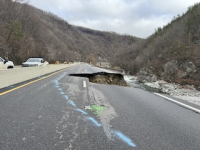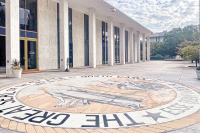To map or not to map? Jackson ponders the question amid spate of rain-induced landslides and steep slope rewrite
Jackson County planning board members are considering whether to re-start a landslide hazard mapping initiative that was axed by the state two years ago.
A team of state geologists had been creating landslide hazard maps for every mountain county. They had just started working on Jackson two years ago when conservative state lawmakers terminated the project, due both to state budget constraints and controversial aspects of the landslide maps.
The planning board is now the midst of rewriting the county’s steep slope development rules, and knowing where landslide prone areas are — and aren’t — could help guide the process. Highlighting the issue of landslides and slopes, a rainy January triggered about 50 landslides in Jackson County.
After the state mapping project ended in 2011, three of the laid-off state geologists formed their own private firm, called Appalachian Landslide Consultants, to continue the work should the counties left with incomplete or non-existent landslide maps choose to finish the mapping on their own.
SEE ALSO: Haywood picks up the torch on landslide hazard mapping
Related Items
“We saw that counties and other organizations still had the need to know where landslides are,” said Jennifer Bauer, one of the geologists with Appalachian Landslide Consultants. “So we decided to start this company to provide that information.”
The firm has already been hired to complete landslide mapping work in Haywood County. Before the project was cut by the state, the team had finished landslide maps for Buncombe, Macon, Henderson and Watauga counties.
But they had just gotten started in Jackson. Out of a three-phase process, they’d only started the first phase, which inventories past landslides in the county. Bauer and fellow geologist Stephen Fuemmeler came before Jackson County’s planning board last week and talked about their work.
To complete the remainder of the work, and provide the county with sets of landslide maps, the cost would be between $160,000 and $200,000. To fund it, the planning board could ask county commissioners or seek assistance from non-profit organizations with an interest in landslides and their effects.
Part of the mapping project identifies houses and structures that are in a hazard zone and could be used by Jackson County residents to avoid being caught in a precarious situation.
“OK, a heavy rain is coming; my house is right in the middle of one of these,” Bauer said. “Maybe I want to go stay in a hotel tonight or maybe I want to go stay with my upslope neighbor.”
Bauer said the maps for Macon had accurately predicted the site of at least one slide during the January rainstorms.
At the same planning board meeting, John Jeleniewski, a code compliance officer with county, gave a brief report about the scope of landslides triggered by the massive soakers that took the county by storm in January.
The landslides spanned the county from Cherokee to Cashiers. One of the largest was near Dillsboro in the Mountain Heritage Estates. It was nearly 2,000 feet long and disturbed about 2.5 acres.
All the landslides documented by the planning department following the January rains had happened on slopes where there had been human disturbance or grading of some sort. Some of the biggest culprits were poorly constructed and unmaintained roads in private mountainside subdivisions and what Jeleniewski called “weekend” type grading work not done by a professional.
Landslides were also reported to have occurred on natural slopes where no work had been done.
Part of the landslide mapping project would be indentify unstable hillsides where incremental shifting or creeping is happening — a precursor to a landslide.
The inventory of past landslides is also a good predictor of future landslides.
“Often landslides will occur in the same location over and over again,” Bauer said. “So it’s good to know where they are.”
Another predictor is a slope where cut-and-fill grading has been done for home sites or roads, Bauer said. When a hillside is disturbed it is more likely to succumb to pressures from rains. Since 1940, 64 percent of documented landslides have occurred on modified slopes.
Landslides on developed slopes can result in millions in property damage and even take lives. According to Bauer, since 1916, 48 people have been killed due to landslides in Western North Carolina.
At least one planning board member, board chairman Zac Koenig, expressed an interest in pursuing the consultants’ services and making use of the survey and maps to guide discussion on the county’s hillside development ordinance.
“It certainly would be helpful,” Koenig said. “It’d be wasteful to say ‘let’s do our ordinance and get that (information) later.’ We certainly should incorporate it.”
Planning Director Gerald Green also wanted to explore the idea of contracting with the landslide consultants.
“I tend to think it could help with the steep slope ordinance,” Green said. “But I’d have to see how I could use it, if we go through with it.”
Green said the topic will be discussed at the upcoming planning board meeting and a decision made as to whether to make a request to county commissioners for funding.













